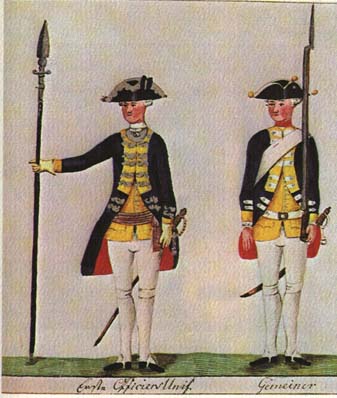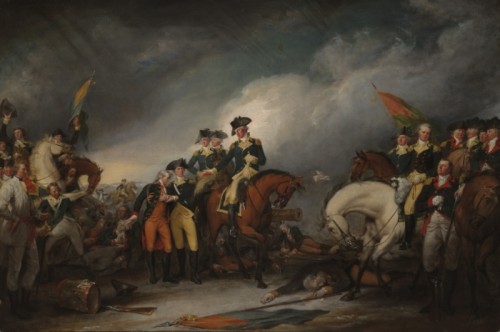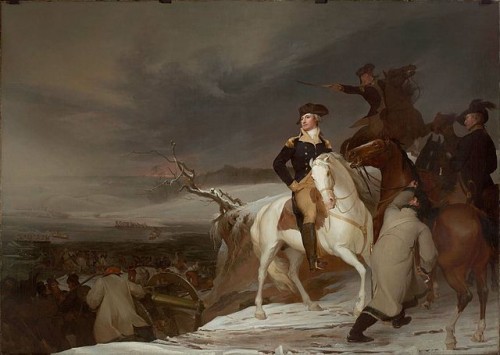Military Monday: Henrich Horn- American Prisoner of War

McMurray Family, Horn Family (Click for Family Tree)
We last left our Hessian ancestor, Henrich Horn, after he was captured by George Washington’s forces at the Battle of Trenton on 26 December 1776. The von Knyphausen Regiment, of which he was a part, had been unable to join the remaining Hessian regiments in town, and moved south along Assunpink Creek where they were captured. Once Henrich’s unit was surrounded and they had stacked their muskets, they were probably terrified as to what would happen next.
Would they be brutally massacred, like so many vanquished forces in a battle? Injured and stripped of possessions, clothing, etc.? (This would have been a concern, since many of the Americans needed coats, hats, even shoes.) What kind of prison would they be put in- the British had notoriously hellish prisons, so the Germans probably feared for their lives with not knowing what the poor, under-equipped Continental Army would provide. And how would they get to where they would be held? The storm was still brutal, it was frigidly cold, and they were terribly exhausted since they had been on duty almost continuously for more than three days, and after coming off strenuous battles before they had marched to Trenton.
George Washington had heard the firing along Assunpink Creek and rode toward the von Knyphausen Regiment as they were being surrounded. He came across some Hessians who were assisting Major von Dechow, Henrich’s commanding officer who had been mortally wounded, into a church. Washington spoke with his enemy, and then an aide returned from the bridge to inform Washington that the last Hessian regiment had been captured. Washington shook the hand of the aide as he said, “…this is a glorious day for our country.”

It is said that George Washington also visited the dying Col. Rall, Hessian Brigade Commander. Rall requested that Washington allow his men to keep their possessions, then died that evening.
It was not such a glorious day for the Hessians. Henrich and his fellow soldiers would have seen the elegant, commanding, General Washington- their great foe for the last eight months- astride his chestnut horse as they waited to learn their fate as prisoners of war.
Those remaining of the von Knyphausen Regiment were marched about three-quarters of a mile down to the old South Trenton Ferry on the Delaware River. They must have been somewhat relieved to realize that maybe they were to survive this battle.
The commander of the Continental Army had a big decision to make- should they hold at Trenton? Washington’s troops had been marching and fighting for over 36 hours straight at that point, and needed rest. Or should they capitalize on their element of surprise and attack another British/Hessian post? The inclement weather would have made that difficult, and his fatigued army might lose all it had gained. Or should they retreat back across the Delaware to safer Pennsylvania, with plunder and prisoners? The last was decided upon as the most prudent action.
Meanwhile, the Continental Army was inspecting the town, looking for the famous plunder of the Hessians- they were reputed to always take much plunder as they travelled. (In fact, some writers claim that Rall’s return to town to take the Hessian guns was more about getting his own possessions and plunder. Some sources report that there were 20 wagonloads of plunder hidden at Trenton.) The rebels happened to find 40 hogsheads of rum (a cask that holds about 63 gallons). Washington ordered the rum to be destroyed, but he likely only heard about it after quite a few hogsheads had been tapped and the contents ‘claimed’ by the American troops. The troops celebrated their hard-won victory as they “drank too freely to admit of Discipline or Defence,” per one of their officers. They paraded around in the pointed brass caps of the Hessians, and had a good time despite the cold and exhaustion.
Being inebriated might have kept the American troops warmer on that frigid day, but it did make getting them back across the Delaware challenging. They also had 848 Hessian prisoners to move, as well.

The Americans sent the Hessians over the frigid, ice-clogged Delaware before the majority of their own men crossed. Although the width of the river was only about the equivalent of four city blocks, the continued poor conditions and exhaustion of all the men, rebel or Hessian, made it twice the ordeal as the crossing had been on the way to Trenton.
American soldiers assisted with the escort of Hessians over the river, using flat-bottomed boats or scows. Our Henrich Horn might have been in one of these boats, since the von Knyphausen Regiment was the first to have been marched down to the ferry. One Continental soldier later reported that in the scow they were all knee deep in both snow and rain, and he said of the Hessians: “some of the poor fellows were so cold that their underjaws quivered like an aspen leaf.”
The icy river was still clogged with ice floes, and ice formed on the boats themselves. The additional surface area from the ice caused the heavily-laden boats to be carried downstream in the strong current, as well as increase the weight and make it harder to row or pole across. To remove the ice and keep the boats crossing the shortest distance, the experienced New England boatmen would pound on the boat and stamp their feet. They motioned for the Hessians to jump up and down with them. (Wonder if our Henrich was on one of these boats instead?) The Americans got quite a chuckle out of the sight- the impeccably uniformed Hessians (though battle-worn) had a tight cue/queue (braid or tightly wrapped ponytail) of hair that stuck straight out the back. The jumping made the queue bounce up and down as well. The Americans were quite amused- and probably proud- to see that they had reduced their formerly terrifying Hessian enemy to looking very silly at that point.
Some of the transport boats were carried down the river by the swift current, and there was too much ice along the shore for the boats to land. One group of Hessian prisoners had to abandon their boat and walk for seventy feet through the icy water. Breaking through the ice, they were finally able to go ashore in Pennsylvania. Was our Henrich in this group instead? We will probably never know what he endured after being taken a prisoner during his transport, but whichever scenario, it must have been frightening and miserable.
The Americans had all the same problems with their crossing, although it was even worse for many. Some of the Americans were so drunk from Hessian rum that they missed when leaping into the boats, and landed instead in the icy river. Others walked out on the thick ice near shore, but then it broke, dropping them into the creek and soaking them, their gun, and ammunition. Most of the Americans had to wait patiently while the Hessians were ferried across, but it was cold and had started to rain. Many were injured or sick, and exhaustion clouded their joy in victory. The snow was melting somewhat from the rain and slightly warmer daytime temperature, and thus they had to march through pools of water/slush, many of them without shoes. The artillerymen had it tough too- in addition to themselves, they had to get heavy guns through the melting snow and mud, despite many of the guns having damaged carriages, wheels, or axles from the firefight.
Our modern-day Google maps tell us that it is 14 miles and 20 minutes via car on the highway from Trenton, New Jersey to Newtown, Pennsylvania, the home base of the Continentals. Google also claims it is an 11.3 mile walk north along the river and then west to get to Newtown from Trenton, and the walk will take 3 hours and 46 minutes today. But how long would it have taken our cold and wet soldiers, both Hessian and American, to make that trip over slushy and frozen ground, through snow drifts, with frozen limbs, fever, dysentery, battle wounds, soaking wet clothes, and feet torn up due to lack of shoes? Think of how far they each had already marched in the previous 2 days, run in battle in Trenton, and the strength needed to fight with bayonets since their ammunition was not working well in the wet weather, plus the exertion of getting heavy boats across the ice-filled Delaware (twice for the Americans). Add in carrying heavy muskets, ammunition, and moving heavy artillery (would the Hessians have been used to help?) on the march to Pennsylvania, and we can only imagine the state of all these weary men as they finally reached camp.
The Americans were probably still elated with their victory, and they were relatively safe in their own camp in Newtown. But the Hessians had to worry- what would happen to them next? They were now in the midst of their enemy- a people they had fought, brutalized, plundered, and murdered as they moved through the country before their capture at Trenton. They surely knew how hated the Hessians were to the American people, even those loyal to the Crown who had been indiscriminately attacked as well by Hessian and British forces. To add to their fear, the Hessians had been told by the British that the Americans treated their POWs terribly, with no regard to the conventions of war. The Hessians could not accept the American people wanting ‘liberty’ from a righteous king, and felt they were greedy as they had so much more than a common Hessian family had in Germany, yet wanted more. Although there were quite a lot of Germans who had immigrated to the colonies before the war, the Hessians would stand out and could not easily escape due to their language and cultural differences. How would this enemy now treat them as prisoners?
The officers had been separated from their men, who were thrown into a hurriedly prepared, makeshift, “dreadful prison,” per Johannes Reuber, a captured Hessian common soldier. Food was dropped to them through a hole in the roof, and the Hessians felt they were being treated as animals.
Heinrich Horn and his fellow POWs likely did not rest well that night, despite their utter exhaustion.
More to come on Henrich Horn…
Notes, Sources, and References:
- Washington’s Crossing by David Hackett, 2004. Winner of the 2005 Pulitzer Prize for History, this tells the story of the crossing of the Delaware and the Battle of Trenton, mostly from the American point of view. This is an excellent book, and very well-written.
- The Hessians and the other German Auxiliaries of Great Britain in the Revolutionary War by Edward J. Lowell. Harper and Brothers Publishers, New York, 1884.
- AmericanRevolution.org: “The Hessians,” chapter VIII, an excellent read- http://www.americanrevolution.org/hessians/hess8.php
- Journal of the Fusilier Regiment v. Knyphausen From 1776 to 1783, possibly by Lt. Ritter? See http://freepages.military.rootsweb.ancestry.com/~amrevhessians/journal1.htm#navbar
- Henrich Horn http://freepages.military.rootsweb.ancestry.com/~amrevhessians/oh/hwardhorn.htm
- Hessians Remaining in America: http://freepages.military.rootsweb.ancestry.com/~amrevhessians/a/amhessians10.htm#navbar
- Wikipedia articles:
https://en.wikipedia.org/wiki/Battle_of_Trenton https://en.wikipedia.org/wiki/Order_of_battle_of_the_Battle_of_Trenton https://en.wikipedia.org/wiki/Wilhelm_von_Knyphausen - The Hessians. Mercenaries from Hessen-Kassel in the American Revolution, by Rodney Atwood, Cambridge University Press, 1980.
- The Hessians and Other German Auxiliaries of Great Britain in the Revolutionary War, by Edward J. Lowell, Harper & Brother, New York, 1884 Republished by Forgotten Books, 2012.
- 10. A Generous and Merciful Enemy. Life for German Prisoners of War during the American Revolution, by Daniel Krebs. University of Oklahoma Press, 2013.
Please contact us if you would like higher resolution images. Click to enlarge images.
We would love to read your thoughts and comments about this post (see form below), and thank you for your time! All comments are moderated, however, due to the high intelligence and persistence of spammers/hackers who really should be putting their smarts to use for the public good instead of spamming our little blog.